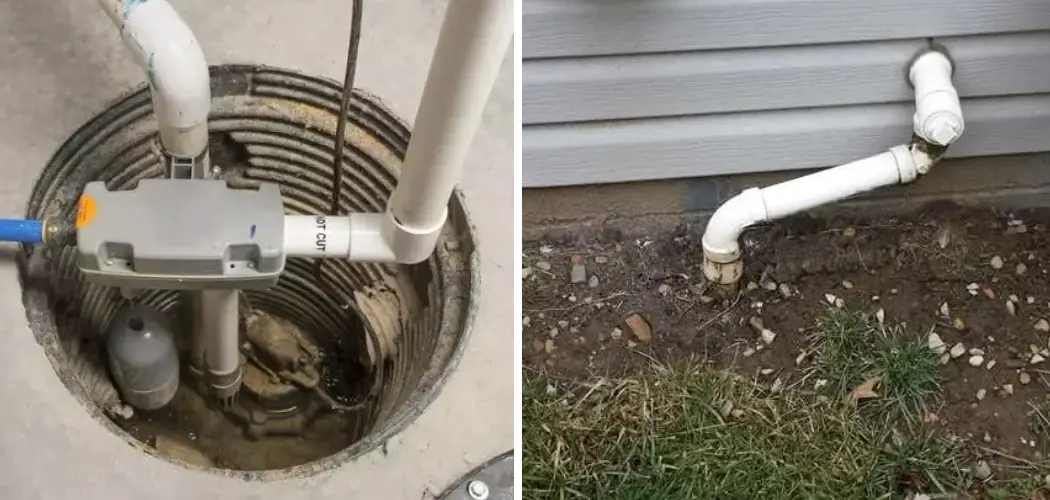Sump pumps are essential for keeping your basement or crawl space dry. They remove excess water that can accumulate due to rain, groundwater, or melting snow. However, the pump’s discharge pipe can pose a problem during cold weather. If uninsulated, the water inside the pipe can freeze and block the flow of water from your sump pump.
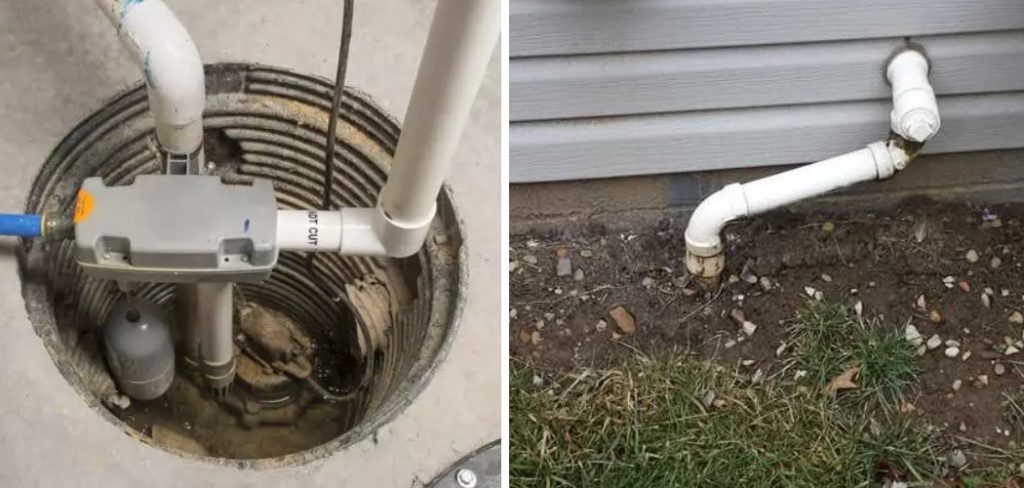
This can cause flooding and damage to your basement or crawl space. Insulating your sump pump discharge pipe is important to prevent this. In this guide, we will discuss the steps on how to insulate sump pump discharge pipe. So, let’s get started!
Understanding Sump Pump Discharge Systems
Before we dive into the steps of insulating your sump pump discharge pipe, it is important to understand how a sump pump discharge system works. The water collected by your sump pump is transported through a discharge pipe that leads outside your home.
This pipe can be either PVC or corrugated plastic and usually measures 1 ½ to 2 inches in diameter. The pipe should be sloped away from your home to ensure proper drainage.
Why Insulate Your Sump Pump Discharge Pipe?
Insulating your sump pump discharge pipe is crucial for preventing freezing during cold temperatures. When the temperature drops, the water inside the pipe can freeze and create a blockage, which can cause serious damage to your sump pump system.
A blocked discharge pipe can also lead to the pump working overtime, increasing your electricity bill and shortening the pump’s lifespan. By insulating your sump pump discharge pipe, you can prevent these issues and ensure your sump pump works efficiently all year round.
Tools and Materials You Will Need to Insulate Sump Pump Discharge Pipe
- Insulation Foam Pipe Wrap
- Utility Knife
- Duct Tape or Zip Ties
- Measuring Tape
- Scissors
- Protective Gear (gloves, goggles)
Step-by-step Guidelines on How to Insulate Sump Pump Discharge Pipe
Step 1: Measure Your Pipe
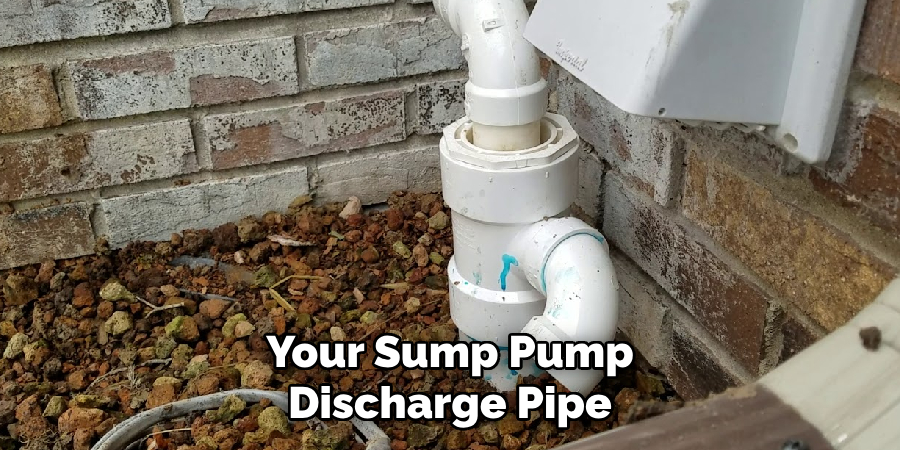
Begin by measuring the length of your sump pump discharge pipe. Make sure to measure from the top of the pump to where it exits your home. This will determine how much insulation foam pipe wrap you will need.
Measuring your pipe will also ensure you do not buy more insulation than necessary. You can use duct tape or zip ties to connect multiple pieces if your pipe is longer than the standard 6-foot insulation foam pipe wrap.
Step 2: Cut the Insulation Foam Pipe Wrap
Cut the insulation foam pipe wrap using a utility knife according to your measurements. Make sure to cut straight and clean lines for a proper fit. Wearing protective gear such as gloves and goggles while handling the utility knife is recommended. While cutting, also make sure to leave a small gap in the insulation where the discharge pipe connects to your sump pump.
Step 3: Wrap and Secure the Insulation
Wrap the cut insulation foam pipe around your discharge pipe. Make sure to cover the entire length of the pipe evenly. Use duct tape or zip ties to secure the insulation in place. If using duct tape, wrap it tightly around the insulation and make sure there are no gaps. If using zip ties, tighten them securely to hold the insulation in place. This will prevent any gaps that can allow cold air to enter.
Step 4: Cover Exposed Joints
If your discharge pipe has any exposed joints or areas where two pipes connect, make sure to cover them with additional insulation. Simply cut small pieces of foam pipe wrap and cover the joints. Secure them in place with duct tape or zip ties. This will ensure there are no gaps where cold air can enter. Make sure to cover any other exposed areas as well, such as where the pipe exits your home.
Step 5: Insulate the Outdoor Portion of the Pipe
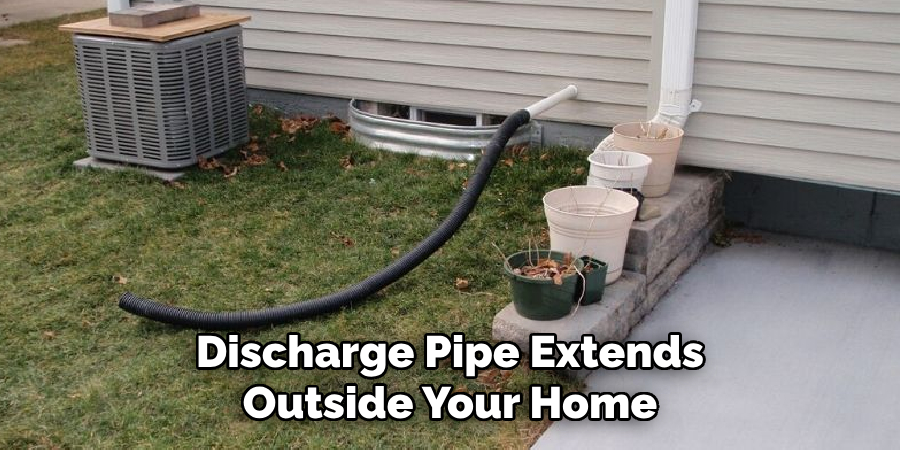
If your sump pump discharge pipe extends outside your home, insulating that portion is also essential. You can use a larger foam insulation tube for this part. Simply wrap it around the exposed outdoor portion of the pipe and secure it with duct tape or zip ties.
This will prevent any cold air from entering the pipe and causing a blockage. Make sure to cover the entire exposed portion of the pipe.
Following these steps will ensure proper insulation of your sump pump discharge pipe and prevent freezing during cold weather. Insulating your sump pump discharge pipe is a simple and cost-effective way to protect your home from potential flooding and damage.
Regularly check the insulation for any wear or tear and replace it if necessary. With proper insulation, you can rely on your sump pump to keep your basement or crawl space dry all year round. So, don’t wait for the cold weather to hit; insulate your sump pump discharge pipe today and know your home is protected. Happy pumping!
Additional Tips and Tricks to Insulate Sump Pump Discharge Pipe

- Heat tape is an effective way to insulate your sump pump discharge pipe, especially during the cold winter months. It works by using an electrical heating element that wraps around the pipe and keeps it warm enough to prevent freezing. This is particularly important for homes located in colder climates.
- Another option for insulating your discharge pipe is to use foam pipe insulation. This can be purchased at most hardware stores and comes in various sizes to fit different pipe diameters. It’s easy to install; simply cut it to the desired length and wrap it around the pipe.
- Consider installing a heat lamp near the pipe if you have a long discharge pipe that runs through a cold or unheated space, such as a crawl space or basement. This will provide additional warmth to prevent freezing.
- It’s essential to regularly check your sump pump discharge pipe for any leaks or damage. Even with proper insulation, extreme temperatures and weather conditions can cause wear and tear on the pipe. If you notice any cracks or holes, make sure to repair them immediately to prevent costly water damage.
- To further protect your sump pump discharge pipe, it’s a good idea to bury it underground at least 12 inches deep. This provides an extra layer of insulation and prevents freezing temperatures from reaching the pipe.
- Keep an eye on your discharge pipe’s location and ensure it’s not near any areas that could become blocked or frozen, such as a gutter downspout or snowdrift. Regularly clear away any obstructions to ensure proper drainage.
- Consider adding insulation to the walls surrounding your sump pump discharge pipe. This can help keep the area warmer and prevent freezing temperatures from affecting the pipe.
- In addition to insulating the pipe itself, make sure to insulate any other components of your sump pump system located in cold or unheated areas. This includes the pump itself and any valves or connections.
- If you experience freezing temperatures for an extended period, running water through your discharge pipe regularly is a good idea. This will help prevent any potential freezing or blockages from occurring.
- Lastly, keeping your sump pump discharge pipe properly maintained and free of debris is important. Regularly clean out any leaves, dirt, or other obstructions that may accumulate near the opening of the pipe.
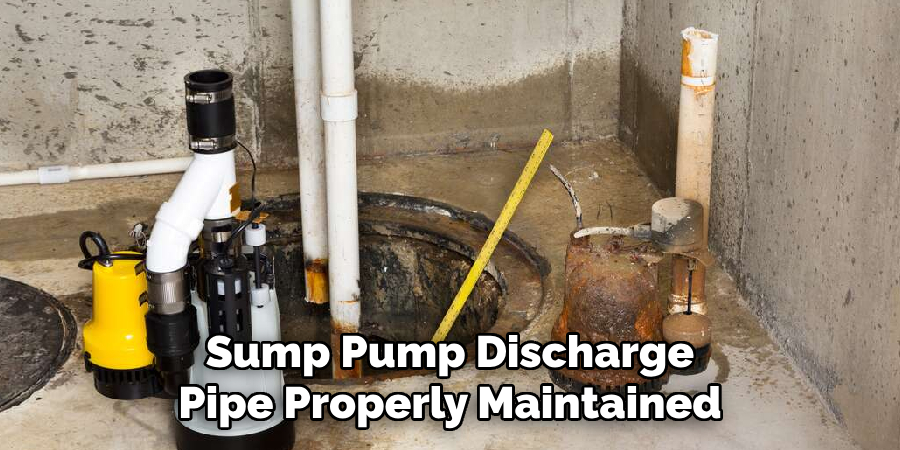
By following these additional tips and tricks, you can effectively insulate your sump pump discharge pipe and ensure it continues functioning properly, even in the coldest of temperatures. Remember to also regularly check and maintain your sump pump system as a whole for optimal performance.
So remember to add these steps to your winter home maintenance checklist! Stay warm and dry with a properly insulated sump pump discharge pipe. Happy insulating!
Things You Should Consider to Insulate Sump Pump Discharge Pipe
1. The first thing to consider when insulating your sump pump discharge pipe is the type of insulation material you will use. The most commonly used materials for this purpose are foam, rubber, and fiberglass. Each material has pros and cons, so choosing one that suits your specific needs is important.
2. Another factor to consider is the thickness of the insulation material. The thicker the insulation, the better it will prevent heat loss and protect the pipe from freezing. However, thicker insulation may also take up more space and make accessing the discharge pipe for maintenance or repairs difficult.
3. It’s also important to consider the climate in which you live. If you live in an area with harsh winters and frequent freeze-thaw cycles, then a higher insulation value will be necessary to protect your pipe from freezing. On the other hand, a lower insulation value may be sufficient if you live in a milder climate.
4. When insulating your sump pump discharge pipe, paying attention to any joints or connections is important. These areas are prone to heat loss and, therefore, should be properly insulated as well. Make sure to use insulation with adhesive backing or tape to ensure a tight seal around these joints.
5. Proper installation is also crucial when insulating your sump pump discharge pipe. Any gaps or holes in the insulation can compromise its effectiveness and leave your pipe vulnerable to freezing. Take your time and make sure the insulation is properly secured and covers the entire length of the pipe.
6. In addition to insulating the discharge pipe, it’s also a good idea to insulate any exposed portions of the sump pump and its plumbing. This will further prevent heat loss and reduce the risk of freezing in colder temperatures.
7. When choosing insulation for your sump pump discharge pipe, be sure to check its compatibility with other materials and chemicals commonly found in wastewater and sewage. Some insulation materials may react negatively with these substances, leading to deterioration or damage over time.
8. Regular maintenance is key to ensuring the effectiveness of your sump pump discharge pipe insulation. Inspect the insulation periodically for any signs of wear or damage and replace it as needed. Additionally, make sure to clear away any debris or obstructions that may prevent proper drainage and cause the pump to work harder.
9. Another important consideration is the cost of insulation materials. While choosing high-quality, effective insulation is important, it’s also necessary to factor in your budget when making the final decision. Research different brands and types of insulation to find one that offers the best value for your money.
10. Finally, following all safety precautions when handling insulation materials is important. Wear protective gear and make sure the area is well-ventilated when installing insulation. If you need help with how to properly insulate your sump pump discharge pipe, consult a professional for assistance.
Considering these factors, you can ensure that your sump pump discharge pipe is properly insulated and protected from freezing. This will not only prevent damage to your plumbing system but also save you time and money on potential repairs in the future.

Remember to regularly inspect and maintain your insulation for optimal performance. Stay warm and dry with a well-insulated sump pump discharge pipe! Let us know if you have any other tips or tricks for insulating sump pump discharge pipes. We’d love to hear from you! Happy insulating!
Precautions Need to Be Followed for Insulating Sump Pump Discharge Pipe
- First and foremost, make sure to turn off the sump pump before starting any work. This will prevent any accidents from occurring and ensure your safety.
- Carefully remove any existing insulation or debris from the discharge pipe. Use a wire brush or sandpaper to clean the surface of the pipe and ensure proper adhesion of new insulation.
- Measure the length of the discharge pipe to determine how much insulation you will need. Using foam pipe insulation with a minimum thickness of 1 inch is recommended for optimal protection against freezing temperatures.
- Cut the foam insulation to fit the length of the discharge pipe, leaving a small gap at the top and bottom for air circulation.
- Use foil tape or duct tape to secure the edges of the insulation together. This will ensure that the insulation stays in place and prevents any gaps or openings where cold air could get in.
- Cover any joints or connections with additional insulation, such as T-joints or elbows. These areas are more susceptible to freezing and should be properly insulated.
- Secure the insulation in place with zip ties or pipe clamps if necessary. This will prevent any movement and ensure that the insulation stays in place.
- For added protection, consider adding a layer of heat tape to the exterior of the insulation. This will provide an extra level of warmth during extreme temperatures.
- Regularly check the condition of the insulation and replace it if necessary. Over time, insulation can wear down and become less effective, so it is important to monitor its condition.
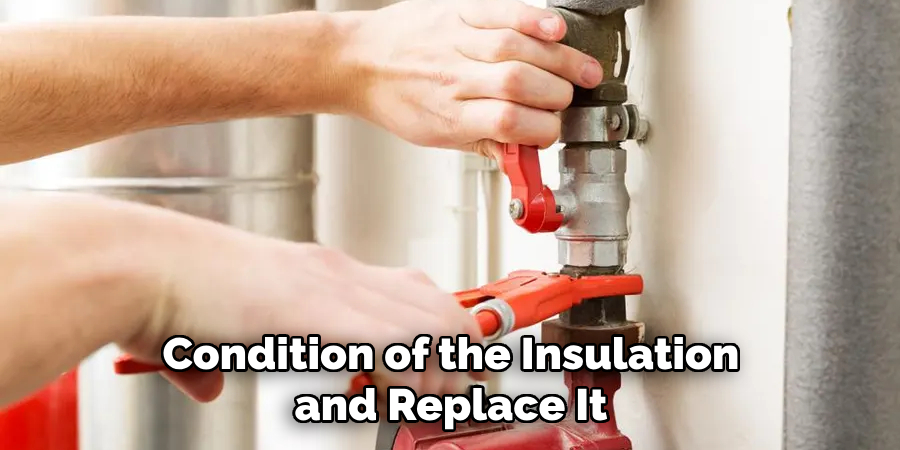
Following these considerations will help ensure that your sump pump discharge pipe is properly insulated and protected against freezing temperatures. Always prioritize safety and consult a professional if you need help with how to properly insulate your sump pump discharge pipe. By taking these precautions, you can prevent costly damage and keep your sump pump running efficiently all year round.
Frequently Asked Questions
What is a Sump Pump Discharge Pipe?
A sump pump discharge pipe is a component of the sump pump system that carries water from the sump pit to the outside of your home. It is typically made of PVC or other durable materials and is installed vertically to allow for proper drainage.
Why Do I Need to Insulate My Sump Pump Discharge Pipe?
Insulating your sump pump discharge pipe can prevent freezing during colder months. When temperatures drop, the water in the pipe can freeze and cause blockages, which could damage your sump pump or cause water to back up into your basement. Insulation helps to maintain a consistent temperature and prevent freezing.
How Do I Know If My Sump Pump Discharge Pipe Needs Insulation?
If you live in an area with cold winters and have experienced frozen discharge pipes, insulating your sump pump discharge pipe is recommended. Additionally, insulation is necessary to protect the pipe from freezing if your sump pump is located in an unheated area, such as a crawl space or garage.
What Materials Do I Need for Insulating My Sump Pump Discharge Pipe?
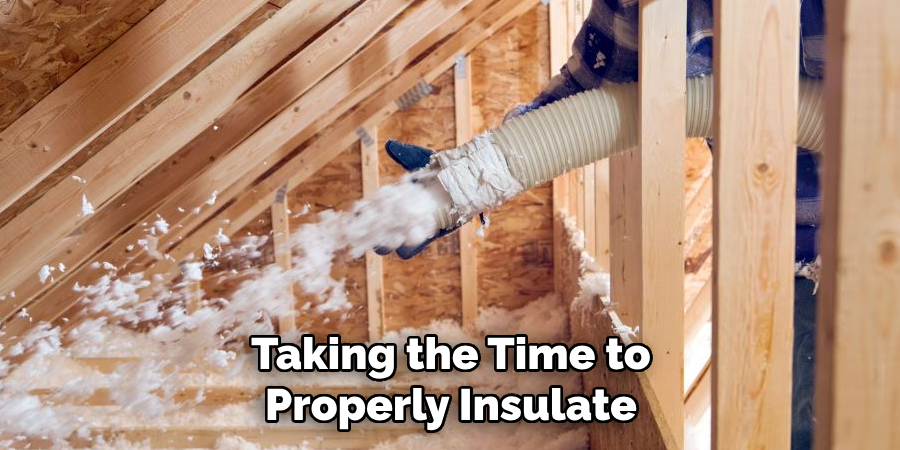
You will need foam or rubber pipe insulation, duct tape or zip ties, and a utility knife to insulate your sump pump discharge pipe. You may also need a heat gun or hairdryer to help secure the insulation in place.
Conclusion
Now you know how to insulate sump pump discharge pipe and why it is important. By taking the time to properly insulate your sump pump discharge pipe, you can avoid potential damage and ensure that your sump pump system runs smoothly all year round.
Remember to regularly check and maintain your sump pump discharge pipe insulation to prevent any issues in the future. So, be sure to follow these steps and stay prepared for colder temperatures. Keep your sump pump discharge pipe insulated and worry-free during winter.

